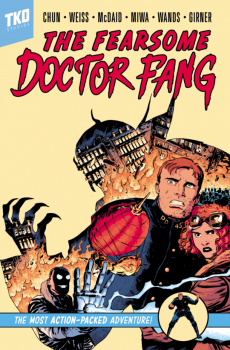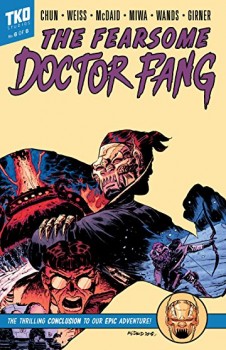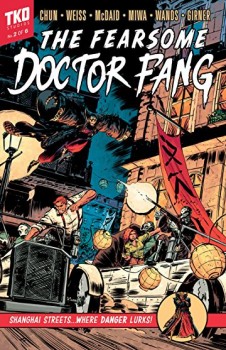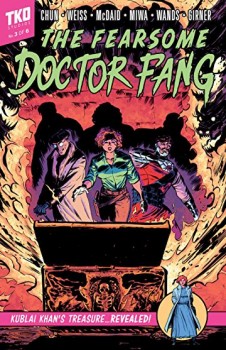Who’s Afraid of The Fearsome Fang?

 The Fearsome Doctor Fang was published by TKO Studios in December 2018. The title only recently came to my attention on the recommendation of a fellow member of The Sax Rohmer Society. As soon as I saw the hero was named Nayland Kelly, I was sold.
The Fearsome Doctor Fang was published by TKO Studios in December 2018. The title only recently came to my attention on the recommendation of a fellow member of The Sax Rohmer Society. As soon as I saw the hero was named Nayland Kelly, I was sold.
Writing new Yellow Peril titles in the 21st Century is understandably a tricky business. James Bond is a rare pulp-influenced franchise to have escaped unscathed despite Dr. No becoming the first of the series to reach the silver screen. The relatively understated yellow-face performance from Joseph Wiseman in the 1962 Sean Connery film never offends audiences the same way Mickey Rooney’s broad Japanese caricature does in Breakfast at Tiffany’s.
Political correctness damns Rooney’s over-the-top and insensitive Mr. Yunioshi while ignoring Jerry Lewis or Vito Scotti doing virtually the same offensive vaudeville routines elsewhere in film and television in the same era. What triggers viewers or readers is often the perception of just how offensive a portrayal is; though some of course would prefer to banish all trace of Yellow Peril and yellowface as a matter of principle.
So I was immediately curious how TKO Studios approached The Fearsome Doctor Fang. I was surprised to see a white hero and heroine on the cover as mixing it up a bit racially seemed the easiest path to navigating through rocky waters. While waiting for the book to arrive, I read up on the publisher. TKO Studios is a relatively new comics publisher on the scene whose approach to distribution is akin to television binge-watching. Multi-part titles are published digitally and in print in their entirety at once. Trade paperback and deluxe collected editions are also immediately available.
The co-creator of The Fearsome Doctor Fang is TKO Studios co-founder Tze Chun. A professional television writer/producer for series such as Gotham and Once Upon a Time and an award-winning independent filmmaker in his own right; it is likely that TKO Studios have an eye on developing their properties for other media.

 This brings us to the series itself and how it approaches Yellow Peril thrillers from the vantage point of the 21st Century and guided by an Asian American creator and publisher. It is safe to say The Fearsome Doctor Fang is firmly rooted in Steampunk. For this reader, at least, this is often a double-edged sword.
This brings us to the series itself and how it approaches Yellow Peril thrillers from the vantage point of the 21st Century and guided by an Asian American creator and publisher. It is safe to say The Fearsome Doctor Fang is firmly rooted in Steampunk. For this reader, at least, this is often a double-edged sword.
One of the most effective moments in the revived Doctor Who for me was when the series traveled back to Britain just before the Great War. The Doctor took on a teaching job at university while his companion Martha became part of the cleaning staff. Martha discovered first hand the differences in racial attitudes in pre-WWI England and her own time. For fans of the series, it was highly effective to see a character you had invested in emotionally treated poorly solely for the color of her skin. During the same season, they visited New York City during the Great Depression as the Empire State Building was nearing completion. An interracial romance occurs during the episode and no one bats an eye. This, to me, is the weaker side of Steampunk – though it is one many consider a strength – that is imagining a past with the mores of the present in the hopes of influencing a better tomorrow.
As someone devoted to nostalgia for the past, I want my history warts and all. I believe context is key and expect period fiction to display what was right and what was wrong honestly for readers and viewers. I think disclaimers in front of reprints of vintage works are entirely appropriate to note that the attitudes displayed were acceptable during colonialist periods, for instance. A work colleague and I were recently discussing Kipling and he voiced the opinion that it isn’t appropriate to read such things any more. I was, unsurprisingly, appalled and pointed out the irony that Kipling, despite his flaws, was quite progressive in his thinking for his time.
Being near my own half-century mark, I grew up well aware of the conservative desire to censor artistic expression to protect the impressionable. Like most kids, I grew up wanting to read books, watch movies, and listen to music without a Moral Majority telling me what I could or couldn’t do. Today, we have a growing movement from the supposedly liberal to likewise mute the past and limit what can and cannot be expressed. Thoughts, it seems, are dangerous and people cannot judge for themselves what they think, but rather must be dictated to by those with their best interests at heart. For me, that sounds awfully like the same dish of excrement served up from the other side of the political spectrum. This then is my issue with historical revisionism as it oftentimes impacts Steampunk or seeks to censor or ban past works of art.

 There is no denying Yellow Peril fiction was racist. Its appeal as nostalgia isn’t out of some bizarre lingering paranoid delusion that Asians with their superior intellect and skills will soon conquer the West; but rather in the appeal of an exotic “foreign other” that tempted both West and East to intermingle. The heart of Sax Rohmer’s Fu Manchu formula is the staid English hero rescuing the seductive Eurasian beauty from Fu Manchu’s clutches and settling down with her not in London, but Cairo and adopting a completely foregin way of life. Egypt called to Rohmer strongly throughout his career, though it was with his highly intelligent and well-educated Eastern “villain” that he made his fortune.
There is no denying Yellow Peril fiction was racist. Its appeal as nostalgia isn’t out of some bizarre lingering paranoid delusion that Asians with their superior intellect and skills will soon conquer the West; but rather in the appeal of an exotic “foreign other” that tempted both West and East to intermingle. The heart of Sax Rohmer’s Fu Manchu formula is the staid English hero rescuing the seductive Eurasian beauty from Fu Manchu’s clutches and settling down with her not in London, but Cairo and adopting a completely foregin way of life. Egypt called to Rohmer strongly throughout his career, though it was with his highly intelligent and well-educated Eastern “villain” that he made his fortune.
The interesting thing with Fu Manchu himself is that he is not the demeaning and grotesque Chinese caricature of his era spewing pidgin-English, but a man who consistently displays more integrity than the British protagonists and never breaks his word. Fu Manchu is a hero from his own ideological perspective, though Rohmer occasionally gives him moments of madness and delusions of grandeur. Much is made of Rohmer’s oft-repeated description of Fu Manchu’s “face like Satan and brow like Shakespeare.” There is no doubt the comparison to the Bard was complimentary, but so was the Satanic reference for an author (and readers) educated in Milton with his Promethean view of Lucifer as the fallen “bringer of light” to man. That is precisely how Fu Manchu and his global secret society view his role, believing the world will be a better place once he wins. There is no mistake that during the lead up to the Second World War, Rohmer had jingoistic Nayland Smith begrudgingly protect the socialist and fascist dictators of Europe from assassination while allowing Fu Manchu to echo his creator’s own stated views in contemporary articles about how best to prevent a Second World War. Rohmer, the Englishman who loved Egypt and told tales of the West’s willing seduction by the East, came to identify more with his supposed villain than his traditional hero – a fact that neatly encapsulates the series’ continuing nostalgic appeal.
So how does a talented and successful Asian-American writer like Tze Chun address the Yellow Peril in the 21st Century? Well, unfortunately by completely robbing the East of its mysterious and intoxicating beauty. I suspected from the outset that TKO Studios were not likely to have created a new Chinese villain to imperil San Francisco in the first decade of the last century, but I did not anticipate the Western characters would fail to fall in love with the East as a place and person. China’s natural beauty and history are portrayed, but it fails to entice the characters or the reader. There are hints that this is the direction the series may move, but there was no ideological conversion to propel the narrative.
I gravitate toward this sort of story because I want to willingly fall under an Eastern spell. What I was given was another entertaining slam-bang globe-trotting pulp adventure that evoked Indiana Jones as much as Republic serials. Apart from the reference to a character with the uncommon first name of Nayland and the series own lurid title, there is nothing else here to recall Rohmer. I was pleasantly reminded of Lyndsay Faye’s Timothy Wilde pulp series with their Irish-American brothers in 19th Century New York. I even detected the lingering specter of Philip Pullman in Tze Chun giving the insidious Caucasian inventor who callously exploits the Chinese people and their environment the surname of Church. One presumes that was a deliberate choice and not simply the author’s subconscious at play.
This being a comic book, I should mention the art as it does as much as Tze Chun and Mike Weiss’ script to convey the story successfully. I suspect Dan McDaid is a Jack Kirby fan and likely influenced by Marvel Comics titles he read in the 1990s as well. At times, the character expressions were amazingly lifelike, but much of the time the coloring washed out the strength of his line art and made me recall unpleasantly early 1980s Whitman/Gold Key titles. Overall, the storyline deserved more than six issues and felt a bit rushed at times with characterization and pace suffering as a consequence. Church and his organization, a version of Edison/Tesla crossed with the Si-Fan, could have benefited from more of a background. This is, of course, a highly opinionated review from someone who loves everything the writers are likely reacting against and who bristles at the very effect they are trying to achieve in blurring the line between a real and idealized past.
William Patrick Maynard was authorized by The Sax Rohmer Literary Estate to continue the Fu Manchu thrillers for Black Coat Press beginning with The Terror of Fu Manchu (2009) and The Destiny of Fu Manchu (2012). His next title is The Triumph of Fu Manchu. His short fiction appears in numerous anthologies and his Blu-ray audio commentaries appear on releases from Shout Factory and Kino Lorber.
‘As soon as I saw the hero was named Nayland Kelly, I was sold.’ – Please expand on this 🙂
Certainly. Nayland Smith is the obsessed British protagonist of the Fu Manchu novels by Sax Rohmer. I mention later in the article that rather uncommon name is very nearly the only aspect evoking Fu Manchu apart from the title.
I haven’t had a chance to read these yet but I ended up buying them after enjoying the first issue
Glad you picked up the set, Glenn. I hope you enjoy them all as much as the first issue.